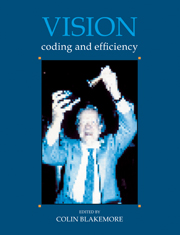Book contents
- Frontmatter
- Contents
- List of Contributors
- Preface
- Reply
- Acknowledgements
- Concepts of coding and efficiency
- Efficiency of the visual pathway
- 5 The design of compound eyes
- 6 The light response of photoreceptors
- 7 Is there more than meets the eye?
- 8 Quantum efficiency and performance of retinal ganglion cells
- 9 Neural interactions underlying direction-selectivity in the rabbit retina
- 10 Detection and discrimination mechanisms in the striate cortex of the Old-World monkey
- Colour
- Brightness, adaptation and contrast
- Development of vision
- Depth and texture
- Motion
- From image to object
- Index
6 - The light response of photoreceptors
Published online by Cambridge University Press: 05 May 2010
- Frontmatter
- Contents
- List of Contributors
- Preface
- Reply
- Acknowledgements
- Concepts of coding and efficiency
- Efficiency of the visual pathway
- 5 The design of compound eyes
- 6 The light response of photoreceptors
- 7 Is there more than meets the eye?
- 8 Quantum efficiency and performance of retinal ganglion cells
- 9 Neural interactions underlying direction-selectivity in the rabbit retina
- 10 Detection and discrimination mechanisms in the striate cortex of the Old-World monkey
- Colour
- Brightness, adaptation and contrast
- Development of vision
- Depth and texture
- Motion
- From image to object
- Index
Summary
Photoreceptors perform the first step in the analysis of a visual image, namely the conversion of light into an electrical signal. The cellular mechanism of this process of energy transformation or transduction has become much clearer in recent years as a result of advances in the study of the biochemistry and physiology of single photoreceptors, and it is on this aspect that this brief review mainly focuses. It should not be forgotten, though, that photoreceptors perform a more complex task than mere energy conversion and amplification. Photoreceptors adapt by altering the gain of transduction to accord with the prevailing level of illumination, and they thereby widen the range of light intensities over which they can respond. The first stage of temporal analysis occurs in the photoreceptors: time-dependent conductance mechanisms in the inner segment membrane ensure that the voltage signal which drives the transfer of information to second-order cells reaches a peak earlier than the current change across the outer membrane. Finally, the synaptic transfer itself seems to be highly nonlinear, so that even a small hyperpolarization caused by steady illumination greatly reduces the gain of signal transfer. All of these features must be considered by those studying higher levels of information processing in the visual system, and it should be borne in mind that the photoreceptors do not present a faithful spatial and temporal map of the external world to second-order neurons in the visual pathway any more than the visual system as a whole presents an unprocessed image to an imaginary homunculus sitting at the seat of consciousness deep within the brain.
- Type
- Chapter
- Information
- VisionCoding and Efficiency, pp. 65 - 73Publisher: Cambridge University PressPrint publication year: 1991



